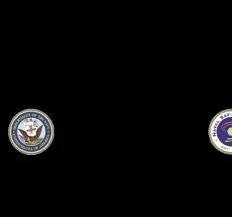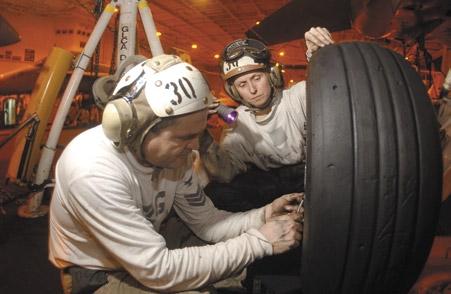
6 minute read
Mishap Stats
need to provide training after deployment. Accordingly, ASM (version 2) has been designed using a humanperformance design (HPD) methodology. HPD helps to build knowledge and job competency into systems like ASM that workers use every day.
HPD is a system that has been designed around common work practices, procedures, and specific individual roles: workers, work-center supervisors (WCS), and training petty officers (TPO).
Advertisement
Software specialists created the ASM HPD, but aviation active-duty and reserve Navy and Marine Corps maintenance SMEs designed it. The system’s rules are based on the NAMP and comply with aviation maintenance requirements.
Views

The personal view, like all the views, consists of a series of tabs that arrange information into logical groups. The first view is the Training Action Plan tab, which shows the “To Do” list (one component of an Individual Training Plan). The structure looks at a specific area, for example the F-18 Tire-and-Wheel Maintenance Training Syllabus. Within that area, users must do a series of On-the-Job Training (OJT) tasks and get them signed off to become fully qualified in F-18 Tire-and-Wheel Maintenance. They use ASM Online to sign off each task, and it displays completion percentages, tracking the curriculum’s progress. The system also includes a testing and grading function, and it maintains the results in the database.
A section called Continuous Training supports OJT on tasks at the Navy Enlisted Code (NEC) or Military Occupational Specialty (MOS) of the Marine Corps. These qualifications normally are supported by formal training courses. This view also has information on upcoming expirations for job-required skills (Qualifications/Certifications) and physicals (such as the flight deck physical).
Work Center
The work-center view is the realm of the WCS and TPO. As a WCS or TPO, the ASM logon and password give access to the Personal View and the Work Center. Tabs allow the user to do the following functions: • Monitor qualification/certificaton records • Manage training action plans • Maintain training completion records • Create/edit worker profiles
In the work-center view, ASM has arranged the tasks into logical groups where users readily access
Flight, Flight-Related, and Ground Class A Mishaps 01/01/2006 to 05/21/2006 Date Type Aircraft Command
01/10/2006 T-39N VT-86 Sabreliner crashed on low-level training fl ight—four fatalities. 01/18/2006 FA-18C Hornet crashed during night-bombing training event. VFA-97

01/27/2006 T-34C VT-27 Mentor crashed in backyard of house near airfi eld—two fatalities. 01/28/2006 FA-18C VFA-25 Aircraft struck ramp and went over the side. Pilot ejected safely—no injury. 02/06/2006 FA-18D VFA-125 Pilot ejected successfully after loss of control following multiple emergencies. 02/17/2006 CH-53E HMH-464 Two aircraft in the same fl ight collided while training near the coast. 02/21/2006 FA-18C Hornet lost at sea during air-to-air training fl ight. VMFA-122

03/03/2006 EA-6B VAQ-135 Prowler crashed during low-level fl ight after engine failure—all safely ejected. 03/25/2006 AV-8B VMA-513 Harrier landed on a closed runway. No injuries. Aircraft and construction equipment damaged. 03/27/2006 MV-22B VMMT-204 During post engine-start checks, aircraft went airborne and landed hard. 04/30/2006 FA-18E VFA-14 Hornet had right engine fi re during takeoff. Pilot aborted and exited on runway. 05/05/2006 FA-18A+ VFA-201 Aircraft had severe bleed-air leak during fl ight, burning part of the aircraft.
Class B Mishaps Date Type Aircraft Command
01/12/2006 SH-60F HS-4 Sonar transducer departed the aircraft during sonar-raise evolutions. 01/26/2006 TAV-8B VMAT-203 During vertical landing, Harrier had a hard landing, rolled up on right outrigger and nose wheel. 02/10/2006 T-45C CTW-1 Engine ingested landing gear safety pin during post-fl ight T/S. 03/12/2006 FA-18E VFA-22 Hornet experienced right AMAD pressure caution during a CAS mission. 03/16/2006 AH-1W On a combat-sustainment sortie, helo had a hard landing. HMLA-269
03/18/2006 FA-18D VMFA (AW)-533 Aircraft had a brake fi re after a high-speed abort—no injuries. 03/31/2006 TH-57B Aircraft crashed at an outlying fi eld. HT-8
04/05/2006 FA-18C VFA-81 04/05/2006 FA-18F VFA-11 During taxi, right wing of Hornet No. 1 hit the left wing of a parked aircraft. 04/25/2006 FA-18C Engine FOD on approach to landing. VMFA-314
05/07/2006 FA-18E VFA-22 Left brake caught fi re after a high-speed abort on the runway. 05/12/2006 AV-8B Aircraft departed runway after landing. VMA-231
05/15/2006 SH-60F HS-8 Main rotor blades and stabilator damaged during a precautionary landing.

Printed as a supplement to Mech from Naval Safety Center Data Cdr. Ed Hobbs For questions or comments, call Dan Steber (757) 444-3520 Ext. 7247 (DSN 564)
ASM helps track the training that maintainers need and have completed.

them. The records viewed are for these people in a work center, and a user can manage their training action plans and OJT through ASM.
Pull-down lists exist for each program and qualification, and they can be assigned as tasks maintainers must complete. Once assigned, they appear on the individual’s to-do list, and progress can be checked in the workcenter view and the worker view. Included in this area are the Naval Aviation Logistics Command Management Information System (NALCOMIS) and OJT wing minimums and qualifications.
The fleet administrator is responsible for a periodic upload of NALCOMIS data and will also take care of personnel account administration (new and transferred accounts). This person also will keep task lists current through periodic updates.
Reports are available throughout ASM and are based on the data contained within the system. Reports include a Training Summary, Proficiency List, Personnel Report, and the Monthly Maintenance Plan (MMP). Customized reports also are available.
ASM can share information with other significant Navy databases, such as CETARS, NTMPS, and NALCOMIS. From NALCOMIS, ASM can download OJT information, which will ensure that the work record of all ASM users is synchronized with the NALCOMIS system.
The ASM system provides the following benefits to the aviation-maintenance community: • Automates training administration and readiness assessment • Task Lists integrate/standardize and track schoolhouse training; fleet in-service technical training; general military training; on-the-job training; qualifications, certifications, and licenses; and professional and personal development • Provides uniform controlled, task-specific training by: - Providing local access to state-of-the-art training tools
Navy photo by PH2 James A. Farrally II

- Providing focused, just-in-time remedial/ refresher training - Real-time assessment of training deficiencies • Produces user-defined training and readiness metrics and reports • Performance centered design based on common work processes • Context-Sensitive Access to Naval Aviation Maintenance Plan (OPNAV 4790) and other information resources • Can support various types of training documentation • Web-enabled/central server or stand-alone • Online help, frequently asked questions (FAQ)
The system is designed to manage squadron training, but it can be used at Aviation Intermediate Maintenance Departments (AIMD), or any work-center structured organization.
The ASM module is being tested at AIMD Norfolk.
There’s not enough room to include every element or function of the system. However, a web version of ASM is available from the NUWC Division Keyport website. You may log onto the website with user name, and password “johndoe.” Access to some views will be limited to avoid corruption of the ASM database, but this sample will give you an idea of how ASM functions. It also includes a new-user guided tour. The Keyport website is: https://asmv2web.kpt.nuwc.mil/. A flash presentation is at https://amtcs.kpt.nuwc.navy/asm2.0/ asm.html.
Master Chief Green works at NAVAIR in PMA 205. Mr. Seeley works at Naval Undersea Warfare Center, Division Key Port.










